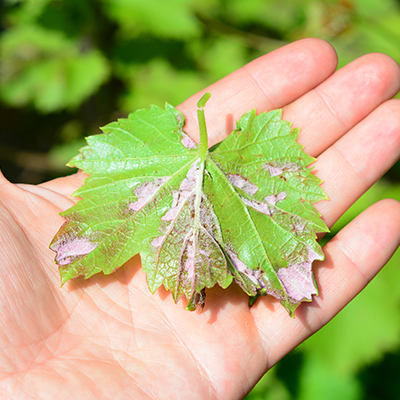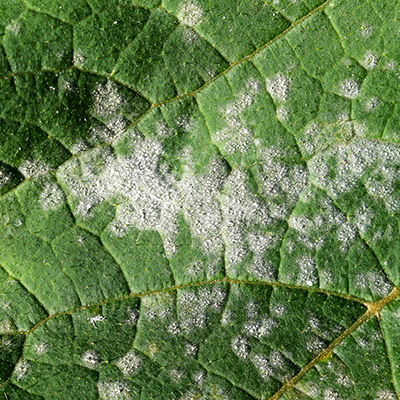Trees are an important part of our ecosystem. They provide oxygen, offer shelter to other forms of life, provide shade, offer beauty, and surround us with tranquility. And though many of them seem tough as nails, they are living elements, vulnerable to illness and diseases just like us. Here in the Dayton, Ohio, area, we have cold winters and hot summers. We experience snow, rain, heat, and drought–all four seasons with various weather elements. This means we also see our share of tree and shrub diseases. So how can you best protect the beloved lawn ornaments on your property? This article walks you through five common tree diseases, how to tell if your tree is infected and what you can do to prevent the disease from infecting in the first place.
Anthracnose
Anthracnose is a term used to describe a group of related fungi that create dead spots on leaves. The fungus is caused by cankers that reside on twigs which, in the spring, produce spores. The spores then get carried by the wind during the spring and spread to other trees. Over time the dead spots can grow bigger and darker, eventually consuming the entire leaf. While this is typically more of an aesthetic issue, the leaf spots reduce the surface area available for photosynthesis resulting in smaller growth. It can also cause stress on the tree making it more vulnerable to other insects and diseases. These fungi can infect any type of tree but primarily go after oak, maple, ash, sycamore, and dogwood.
Anthracnose Prevention and Treatment
Prevention is key with anthracnose as it can be a hard fungus to cure. Once trees become infected with anthracnose, it’s almost impossible to control. You can help protect your trees by making sure they stay healthy with regular fertilizing and watering. Maintaining strong, healthy trees will help keep them resilient to this and other tree diseases. Be sure to rake up and destroy any diseased foliage that falls off the infected tree; this includes all the leaves that fall off in the fall. This will help protect other trees from getting infected.
Iron Chlorosis
Iron chlorosis is a yellowing of plant leaves caused by iron deficiency that affects many desirable landscape plants in and around the Dayton, Ohio, area. Symptoms include yellowing of leaves with dark green veins. In severe cases, the entire leaf will turn yellow while the outer edges turn brown as the plant cells die. New growth of leaves may be stopped completely, and in severe cases, the leaves may die and drop off. It is not uncommon for one half of the tree to suffer from chlorosis while the other half appears normal. Plants commonly associated with chlorosis include holly, apple, blackberry, blueberry, arborvitae, birch, boxwood, lilac, and oak trees. If it lacks in iron, spraying the foliage with an iron supplement can help temporarily.
Prevention and Treatment for Iron Chlorosis
Long-term relief includes better growing conditions. Improve the soil with mulching, proper drainage, and adjusting your soil’s pH balance. If your soil is too acidic, lower the soil pH by adding sulfur, aluminum sulfur, and/or iron sulfate. In order to lower the acidic soil accurately, we recommend calling in a professional landscaping company with the knowledge and training regarding trees and shrubs in Ohio.
Powdery Mildew
Living up to its name, powdery mildew is a white powdery fungus that spreads quickly on the leaves of your shrubs. These spots quickly enlarge, turning into a dusty white or gray coating. The symptoms usually appear late in the growing season. The fungus will steal vital nutrients from your trees and, in turn, slow their production process. Leaves may eventually fall off, and flower buds may fail to open correctly. Like most types of fungi, powdery mildew tends to appear in humid, moist conditions, and it thrives in areas where plants are crowded together and covered in the shade.
Prevention and Treatment for Powdery Mildew
To prevent powdery mildew from getting started, choose varieties of plants bred to be resistant to powdery mildew. If that’s not possible, plant trees and shrubs in full sun, give them plenty of room and reduce the amount of shade surrounding your trees and shrubs by keeping them trimmed and pruned. This will allow for better sunlight and air circulation.
If powdery mildew has only already shown its ugly head, home remedies such as baking soda, combined with liquid, non-detergent soap, and water have been known by gardeners worldwide to be effective. Fungicides can also help prevent the spread of powdery mildew. You should also clean up all dead leaves under and near any infected trees and shrubs so you don’t spread the fungi unintentionally.
Needle Cast
Needle Cast is the most common disease of the Ohio blue spruce caused by the fungal pathogen Rhizospaera. This pathogen invades needles through the pores causing them to turn brown and fall off. Needles on interior branches on the lower canopy are usually infected first. Here, the airflow is limited, shade is more abundant, and moisture sticks on the needles. Once they are infected, symptoms may take up to 12 months to appear. Diseased needles turn brown and fall to the ground. Spores from these infected needles travel through wind and rainwater to other trees. In severe cases, mature trees can be severely defoliated, leaving only a small percentage of living foliage on your beloved spruce tree.
Prevention and Treatment of Needle Cast
When planting blue spruce trees in the Dayton area, don’t plant in shaded areas or tight hedgerows, making them more susceptible. Plant in acidic, moist, well-drained soil and full sun. Utilize healthy maintenance practices so that if environmental stresses such as drought or heavy rain occur, your tree is stronger and more able to resist this and other diseases. Keep an eye on your beloved lawn ornaments and if needle cast has infected the lower canopy, prune to limit the spread and always discard infected needles properly. Affected trees can be treated with a fungicide containing copper as the active ingredient. Fungicide treatments will not cure the disease but will contain it and stop it from spreading.
Apple Scab
Whether you have an apple or crabapple tree in your yard just for show or because you like the taste of the fruit, apple scab is a fungus that infects both the leaves and the fruit. The first sign of symptoms begins with olive-green leaf spots on your leaves and fruit. As the fungus ages, the spots tend to turn dark brown to black, growing larger until the leaf turns yellow and eventually falls off. Infected fruit has olive-green spots that turn brown over time. The fungus spores spread to other branches and nearby trees by wind and water. The more leaves the tree loses, the weaker it becomes, opening it up to the vulnerabilities of other diseases and insects.
Prevention and Treatment of Apple Scab
Because apple scab needs moisture to survive, keep it pruned with an open canopy allowing air to move through the tree and dry the leaves quickly. If leaves become infected, remove them to prevent the spreading of the fungi. Burn or destroy them because they can survive the winter. If the tree is for ornamental use only, fungicides can be used.
Protect Your Trees and Shrubs With Agxact’s Superior Tree and Shrub Care Program
Agxact Lawn and Pest understand firsthand the types of diseases that affect our beloved trees here in Dayton and have developed a five-step tree and shrub application program specifically designed to promote healthy growth and protect your trees and shrubs from diseases, pests, heat, and drought stress. Our tree and shrub care program uses only products that are safe for the environment, your pets, and your family. It will help promote growth, create strength and develop overall healthier trees and shrubs. Contact us now to learn more about this effective program. Reach out to us online, or give us a call today at 937-949-8199.
Did you find the above information interesting and informative? Share with family and friends and check out our other monthly blog articles here.
Where We Service
We currently service these locations and more!
